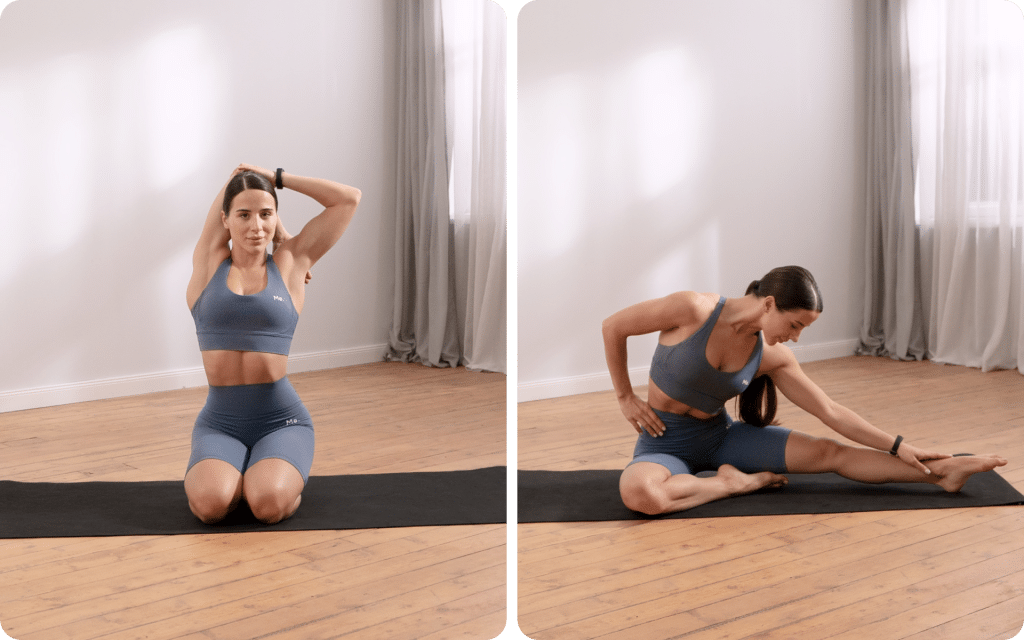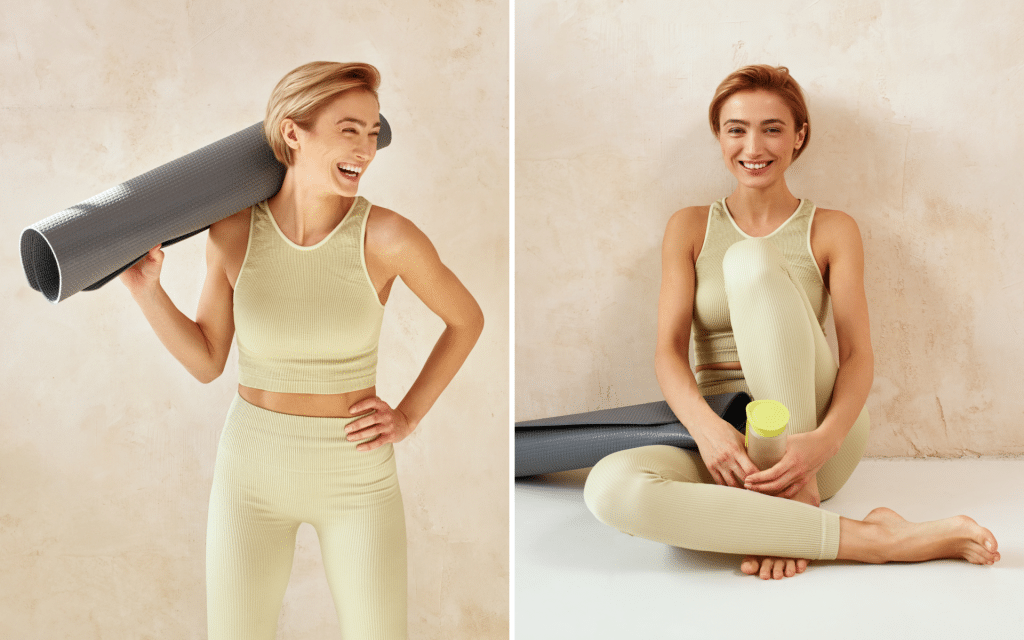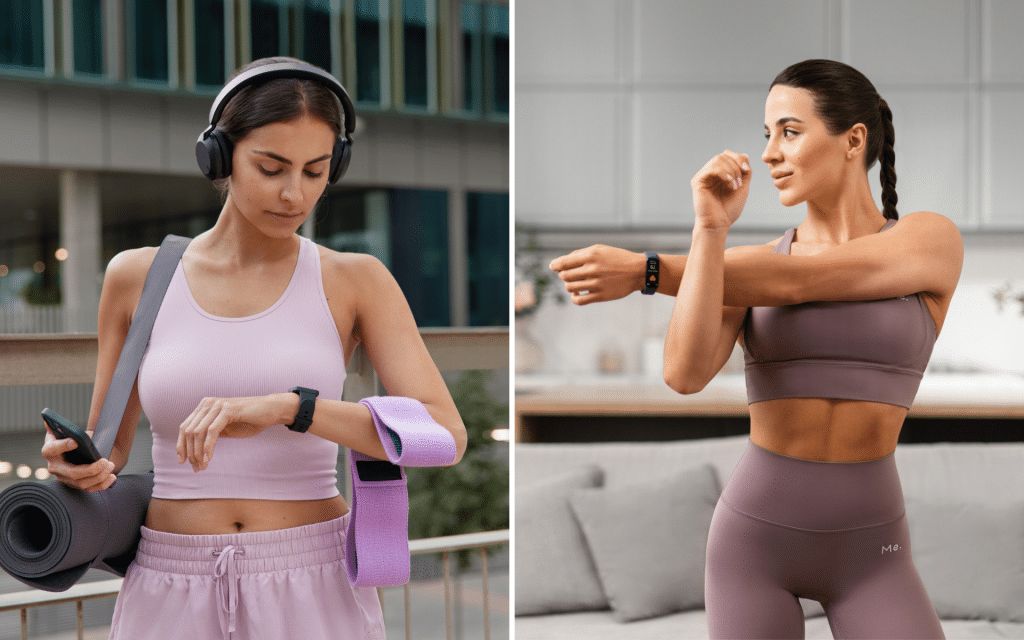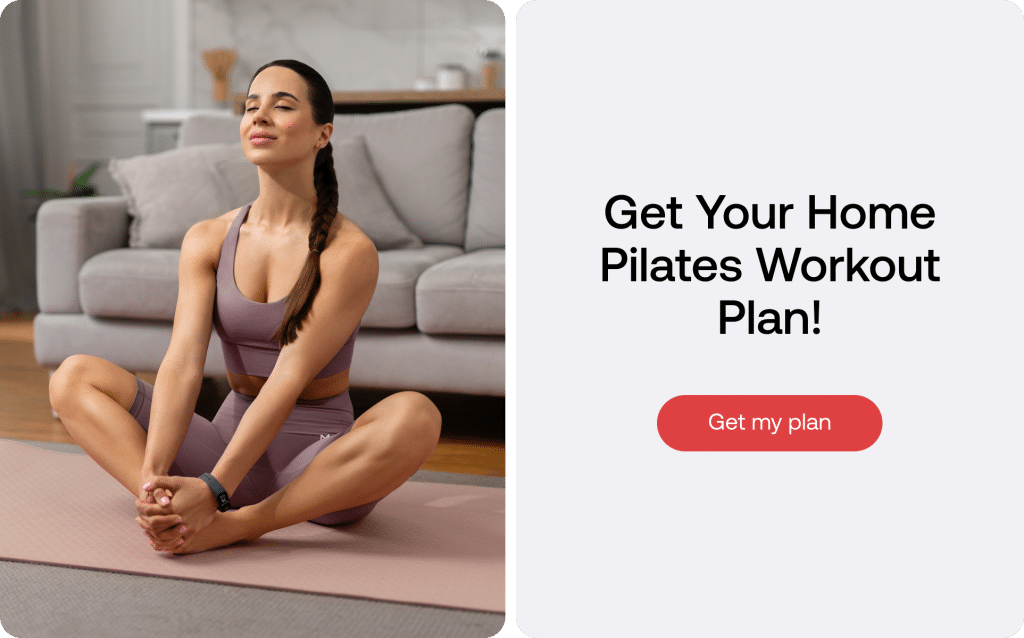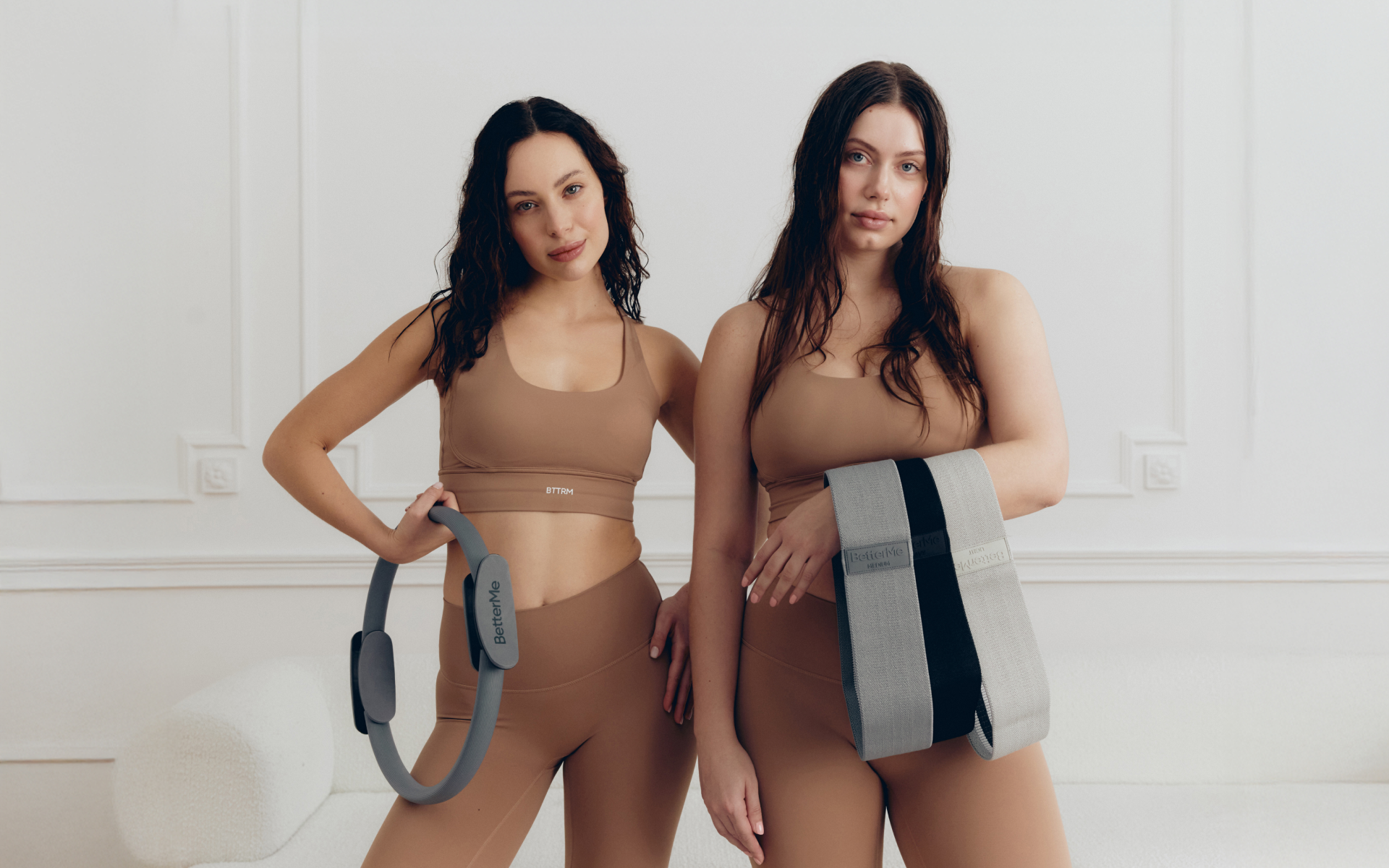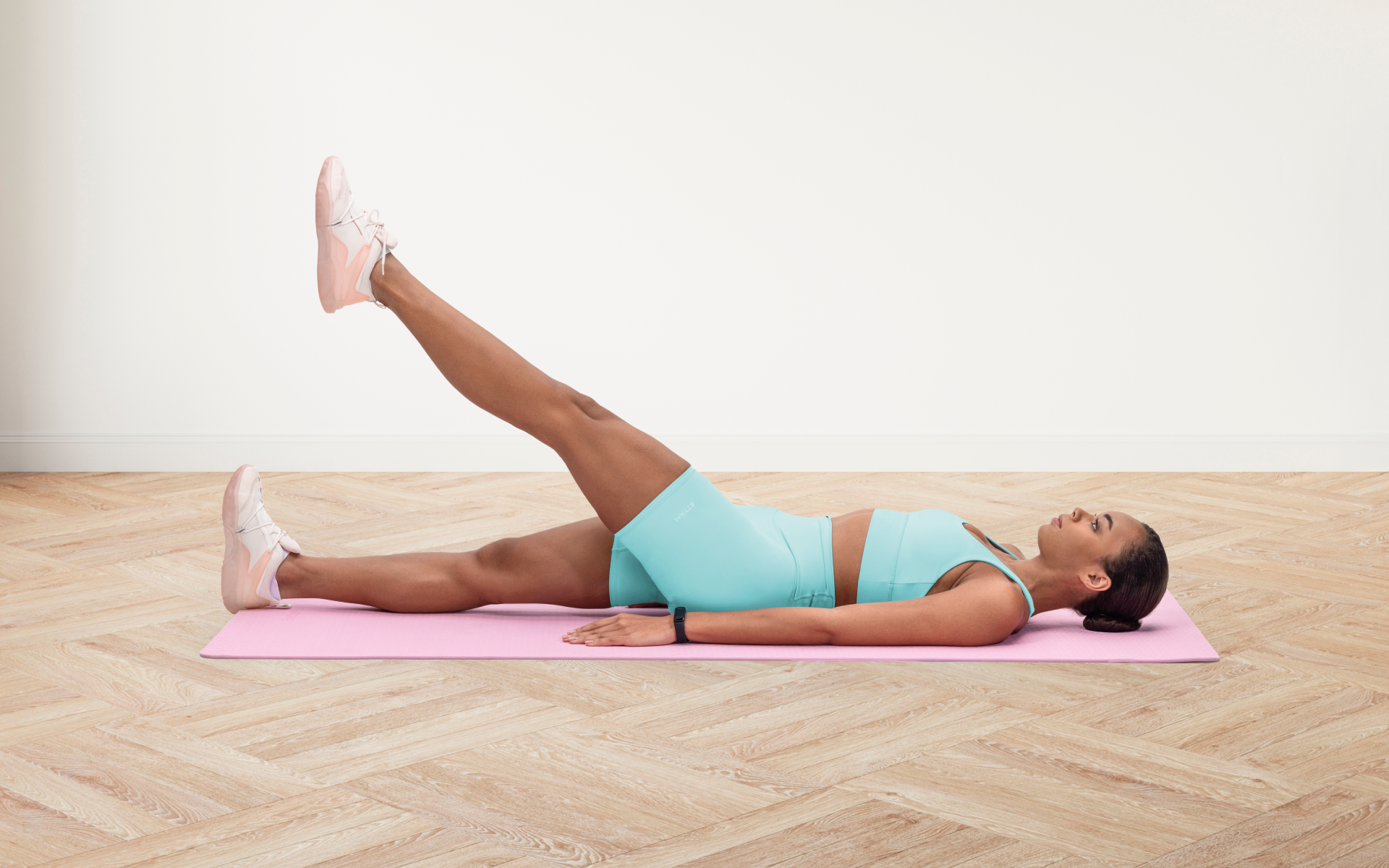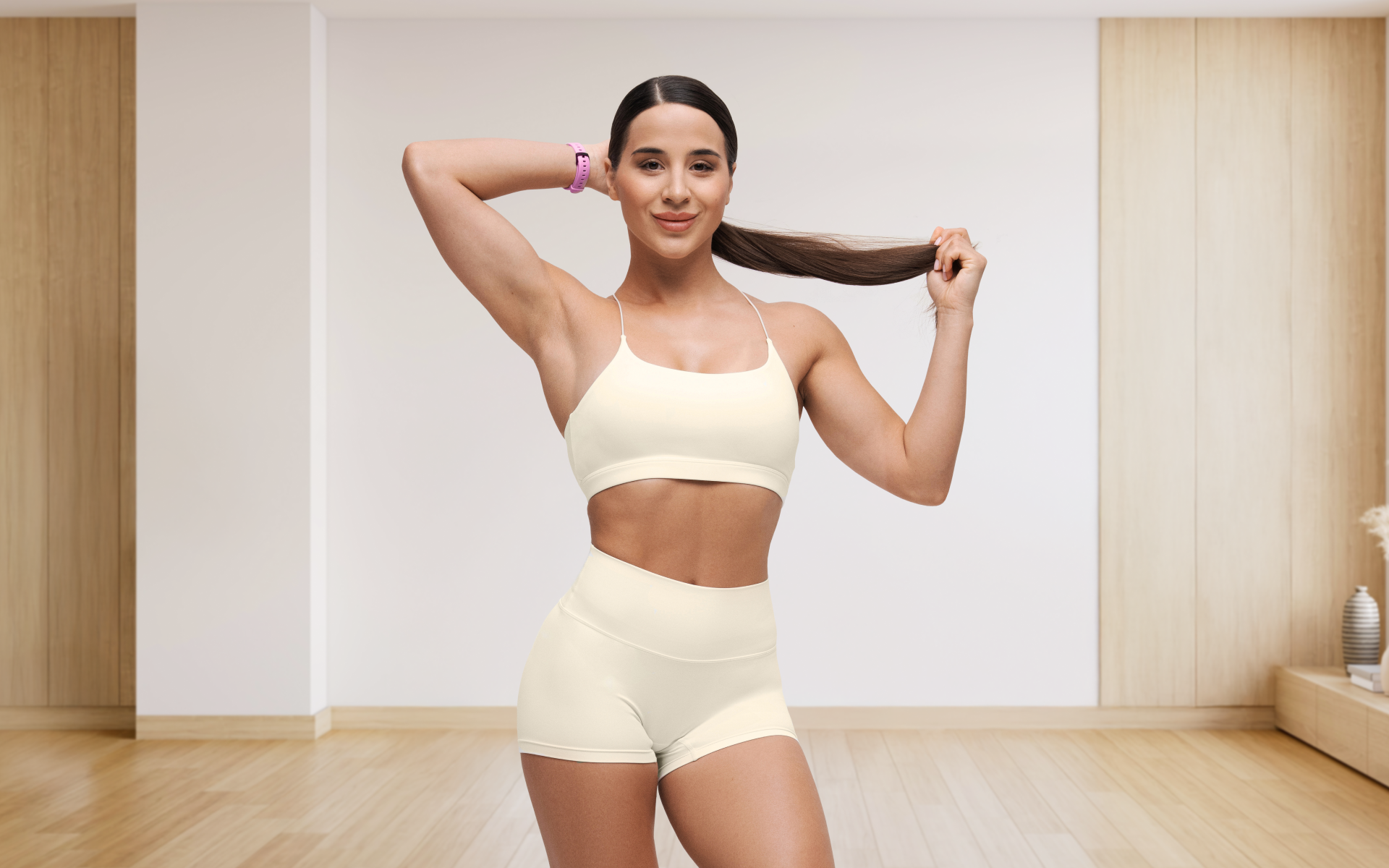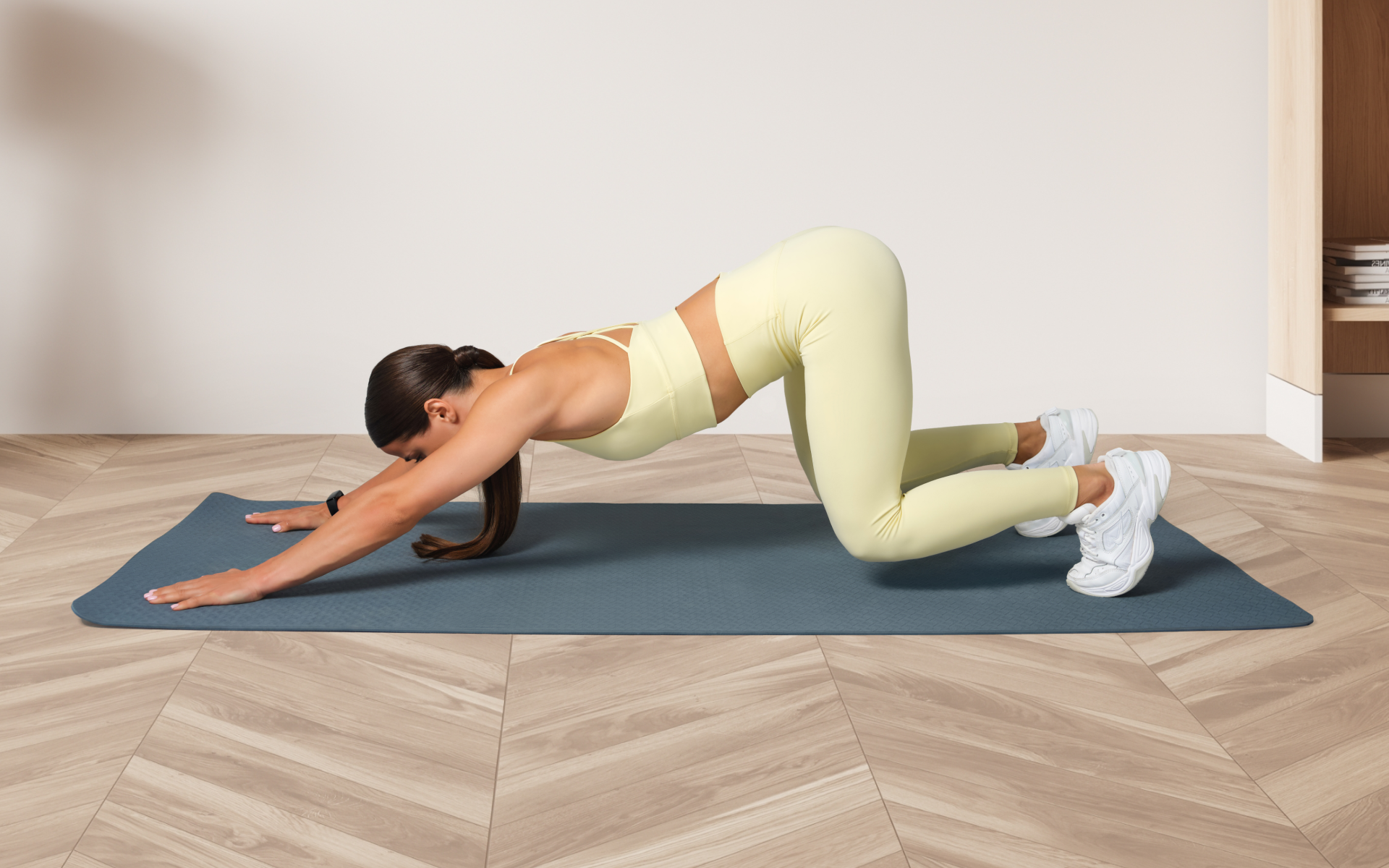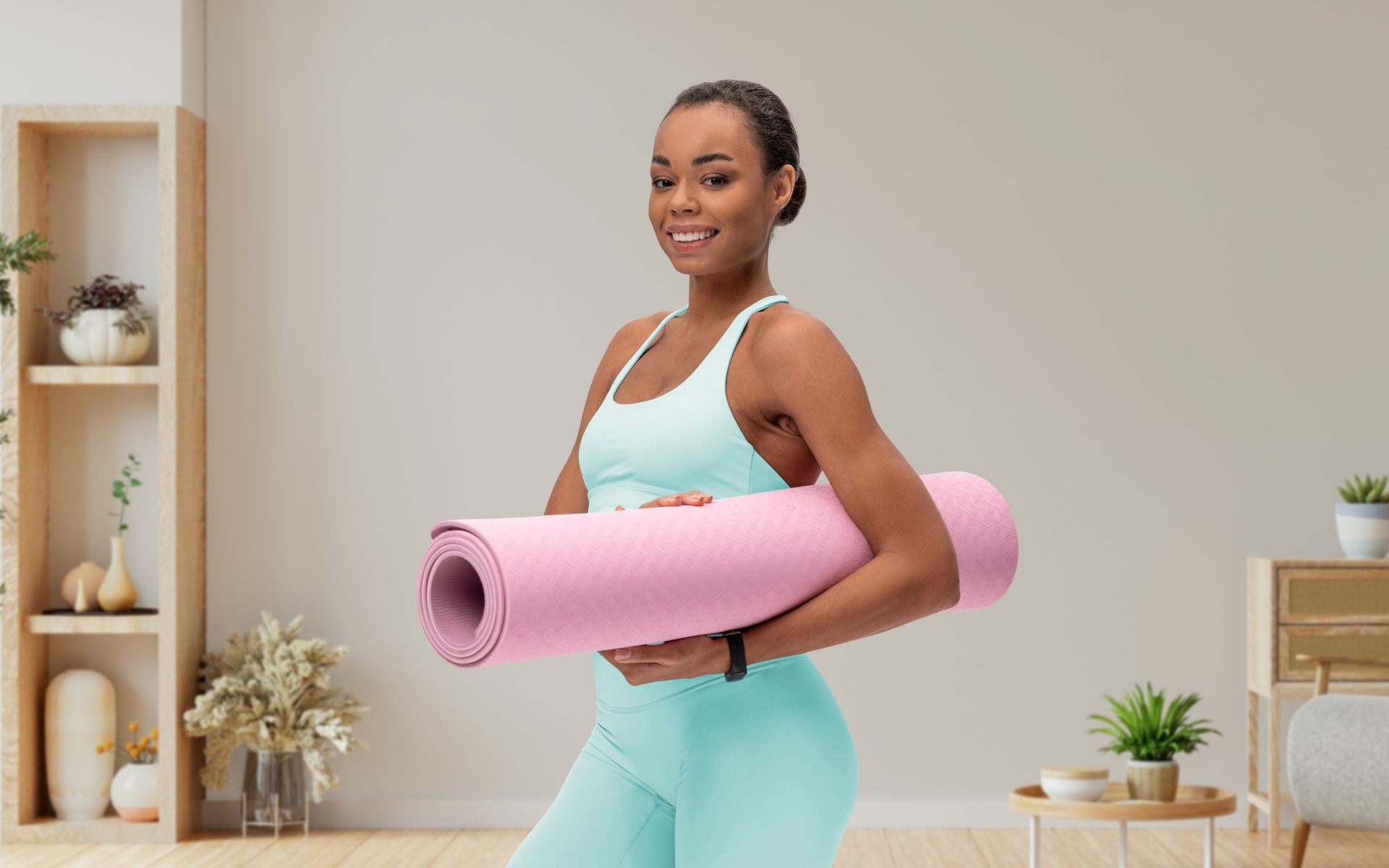Pilates reformer exercises efficiently strengthen and tone the core – the abdominals, back, hips, and pelvis muscles. These exercises require a specialized piece of equipment known as a Pilates Reformer, which consists of a sliding carriage attached to springs that provide resistance (1).
The unique design of the Pilates Reformer allows for a wide range of exercises that target different muscle groups. This article will focus on 8 core-specific exercises that will help you achieve a strong and sculpted midsection.
What Are Some Pilates Reformer Core Exercises?
If you’re wondering what are some effective Pilates reformer exercises, you should check these out:
1. The Hundred On The Reformer
The Hundred is a classic Pilates exercise that activates your transverse abdominis, rectus abdominis, and obliques, building core stability and endurance.
Steps to Perform:
- Lie on the reformer with your feet in the foot straps and arms by your sides.
- Engage your core and lift your legs to a tabletop position, keeping your lower back neutral.
- Curl your head, neck, and shoulders off the reformer and hover your arms above the carriage.
- Begin pumping your arms up and down in small movements while inhaling and exhaling for 5 counts.
- Repeat for 10 full breaths (100 pumps).
2. Plank To Pike
This exercise works your core, particularly your lower abs, while engaging your shoulders and back for support.
Steps to Perform:
- Place your hands on the footbar, shoulder-width apart, with your toes on the carriage. You should be in a straight-arm plank.
- Engage your core and draw the carriage in by lifting your hips into a pike position. Avoid sagging your lower back.
- Slowly lower your hips back to the plank position, keeping control throughout.
- Repeat 8–10 times with steady breathing.
3. Kneeling Abdominals
This movement intensely targets your abdominals, including the obliques, and trains balance and coordination.
Steps to Perform:
- Start kneeling on the carriage, grabbing the ropes or handles with your hands.
- Place your hands on the straps or loops and engage your core.
- Slowly pull your hands back toward your knees, rounding your spine as you move.
- Control the movement as you return to the starting position.
- Repeat 8–12 times, focusing on stability.
4. Short Box Round Back
This exercise strengthens the deep abdominals and improves spinal articulation.
Steps to Perform:
- Sit sideways on the short box, with your feet hooked under the foot strap and your hands behind your head.
- Round your back slightly by tucking your pelvis under and drawing your ribs toward your hips.
- Slowly lower your upper body backward while keeping control and engaging your core.
- Stop before your lower back disengages, then return to the upright position.
- Repeat 6–8 times.
5. Teaser On The Reformer
A challenging full-body exercise, the Teaser activates the deep abdominals and coordination.
Steps to Perform:
- Lie flat on the reformer carriage, holding the straps with straight arms above your head.
- Bring your legs to a tabletop position, keeping tension in the straps.
- Engage your core and lift your head, chest, and legs into a V-shape, extending the legs straight.
- Lower back down with control, maintaining tension in the core.
- Perform 5–8 repetitions.
6. Side Plank With Leg Lift
This exercise strengthens the obliques, transverse abdominis, and outer thighs, training lateral body stability.
Steps to Perform:
- Place one hand on the foot bar and your feet against the shoulder rest, as if in a side plank.
- Lift your top leg slightly to challenge your balance and activate your obliques.
- Hold the position for 10–20 seconds, or add small pulses with your top leg if you want advanced Pilates core exercises.
- Lower and repeat on the other side.
7. Mountain Climber On The Reformer
This dynamic movement targets the core with an extra focus on the lower abs.
Steps to Perform:
- Place your hands on the foot bar and your toes on the moving carriage in a plank position.
- Bring your right knee toward your chest while stabilizing through your shoulders and core.
- Return the right leg to the starting plank position and switch to the left leg.
- Continue alternating legs for 10–12 repetitions on each side.
BetterMe will shake off your mental funk, rid you of your energy-zapping habits, and help you sculpt the body of your dreams. Intrigued? Hurry up and change your life for the better!
8. Mermaid Twist
This exercise strengthens the core, particularly the obliques, and improves spinal flexibility.
Steps to Perform:
- Sit sideways on the carriage, with one leg bent in front and the other behind you, in a mermaid position.
- Hold onto the foot bar with the arm closest to it, extending the opposite arm overhead.
- Engage your obliques as you twist your torso, reaching your top arm toward the opposite side.
- Control the movement as you return to the starting position.
- Repeat 6–8 times before switching sides.
Read more: Pilates Without Equipment: Full-Body Workout At Home
Is Reformer Pilates Good For Core?
Reformer Pilates has a structured approach that targets deep abdominal muscles often overlooked in traditional workouts (2).
How reformer Pilates benefits the core:
- It Targets The Deep Core
The core isn’t just your six-pack. It’s a group of muscles that stabilize your spine, pelvis, and overall posture (3). Key players include the transverse abdominis, which acts like a corset around your midsection, and the obliques, which aid in twisting and bending.
The reformer enhances engagement with these muscles by introducing resistance through springs and pulleys. The added tension from the springs encourages proper muscle recruitment, meaning you activate these stabilizers with more precision than in bodyweight exercises alone.
- Strength Through Controlled Movements
The reformer thrives on what’s called “eccentric” muscle action.
This action refers to the controlled lengthening of muscles, like slowly lowering a weight after lifting. Eccentric movement builds strength and enhances muscle endurance.
Controlled exercises on the reformer—for example, knee stretches or planks—require steady, slow movements. These work your core and train it to perform optimally during everyday tasks, like bending, lifting, or twisting.
- Stability Meets Mobility
Many believe core training is only about strength, but mobility—how well your joints move—is equally crucial. A strong, stiff core without flexibility can lead to dysfunction.
Reformer Pilates combines both elements seamlessly. For instance, exercises like “legs in straps” challenge your core to stabilize while allowing your hips to move freely, improving overall function.
- A Low-Impact Alternative
The reformer provides a safe, low-impact alternative if high-intensity workouts leave you sore or trigger joint pain. It’s especially gentle for those recovering from injuries.
You can strengthen your core without compromising your safety, as the sliding carriage and adjustable springs reduce impact while still providing an effective challenge.
- Functional Strength
What makes reformer Pilates unique is its focus on functional strength. The focus means training the core to perform movements you use daily.
For instance, exercises like the “short spine” movement teach spinal articulation, reinforcing healthy movement patterns that help reduce injuries over time.
- Evidence Supports Its Benefits
Research backs the effectiveness of reformer Pilates core strength exercises.
Studies have shown it improves muscle activation, overall stability, and posture (4).
It may also alleviate lower back pain, which experts link to a weak or inactive core (5, 6).
Can You Get Abs From Reformer Pilates?
Reformer Pilates can build stronger, more defined abdominal muscles.
However, set realistic expectations.
Visible abs aren’t just about building muscle; they also depend heavily on body fat levels.
Reformer Pilates targets the deep core muscles, which are crucial in building a strong foundation for your abs.
These include:
- The transverse abdominis (your internal corset)
- The rectus abdominis (the “six-pack” muscle)
- The obliques along the sides of your torso
The controlled, precise movements required on the Pilates reformer ensure you effectively engage these muscles with every exercise.
Even with a strong core, a layer of body fat can conceal abdominal muscle definition.
Factors like diet, sleep, and stress management greatly affect fat loss (7).
Reformer Pilates can be part of the equation, but it’s not the sole factor.
How Do You Engage Core In Reformer Pilates?
Engaging your core in reformer Pilates is essential for maximizing each movement’s effectiveness. It’s not just about “squeezing your abs”—it’s a whole-body practice that starts with proper alignment and muscle awareness.
Here’s how you can activate and maintain core engagement on the reformer:
1. Understand What “Core” Means
Your core isn’t just your abs. It includes the transverse abdominis (deep stabilizing muscles), rectus abdominis (the six-pack muscle), obliques (sides of your torso), pelvic floor muscles, and even parts of your back (3).
Think of it as the body’s central support system—it helps stabilize the spine and protect you during movement.
2. Start With Neutral Alignment
Neutral alignment means your spine is in its natural curve.
Avoid flattening or over-arching your lower back.
- Lie on the reformer and check that your pelvis is level.
- Keep your ribs connected, meaning they shouldn’t appear “flared” or sticking out.
- Engage your stabilizing muscles to maintain this position before beginning any movement.
3. Focus On Breathing
Steady breathing is crucial for core engagement. Pilates uses what’s called lateral breathing.
This breathing involves expanding your ribcage with each inhale while maintaining core tension (8).
- Breathe in through your nose to expand your sides.
- Exhale through your mouth and gently draw the navel toward your spine to engage the transverse abdominis.
4. Use Mindful Movement
Slow, controlled movements are key in reformer Pilates.
Quick or jerky motions can disengage the core and shift focus to other muscle groups.
- Move deliberately and with control.
- Think about stabilizing your torso even as your arms or legs move.
5. Anchor Your Movements
Anchoring means keeping certain parts of your body stable while engaging the core.
For example:
- Press your lower back gently onto the carriage without flattening it completely.
- Keep your shoulders down and relaxed, away from your ears.
- Holding this position stabilizes the upper body and prevents unnecessary tension.
BetterMe: Health Coaching app helps you achieve your body goals with ease and efficiency by helping to choose proper meal plans and effective workouts. Start using our app and you will see good results in a short time.
6. Apply Opposition
Opposition involves engaging opposing muscle groups to create balance.
- For instance, when doing leg presses, resist the movement by actively pulling your upper body away as you engage your core.
7. Be Aware Of Transitions
Transitions between exercises matter. Many people lose core engagement when shifting between positions.
Focus on maintaining core activation even during rest or between movements.
8. Use Small Adjustments
Subtle corrections can enhance core engagement during reformer exercises.
- Slightly lift your pelvic floor muscles (similar to stopping urine flow).
- Tighten your lower abs gently to create stabilization without gripping too hard.
How Do I Know If I’m Engaging My Core Correctly?
Engaging your core can sometimes feel tricky, especially if you’re new to it.
The key is paying attention to your body and understanding the signs of proper core activation.
Here’s a list to help you assess if you’re doing it right:
Signs Of Proper Core Engagement
- Your Lower Back Feels Supported
If your core is active, your lower back should feel stable but not overly pressed into the floor or carriage. You shouldn’t feel strain or arching in your lower back.
- You Feel Tension In Your Deep Abdominal Muscles
Your transverse abdominis, often called your “deep core,” feels slightly engaged, like your navel gently draws toward your spine. This activation doesn’t involve a hard squeeze or holding your breath.
- Your Ribs Stay “Knit” Together
Your ribcage shouldn’t flare out or lift excessively. Instead, you should feel your ribs stay aligned and connected to your core throughout the movement.
- You Can Breathe Easily
Proper core engagement allows you to maintain a steady, full breath.
You may not correctly engage your core if you hold your breath or strain too much during an exercise.
- Your Pelvis Feels Stable
Your pelvis shouldn’t tilt excessively forward or backward during movements.
A neutral pelvis is a good sign that your core is active and doing its job to stabilize you.
- No Visible “Doming” or Bulging
If you notice your belly pushing outward or a dome shape forming along the midline, it could indicate that your core isn’t activating correctly. Instead, focus on gentle inward activation.
- Your Shoulders And Neck Stay Relaxed
Core engagement shouldn’t cause tension in your upper body.
If you’re straining through your shoulders, neck, or chest, it may mean your core isn’t fully engaged and other muscles are overcompensating.
- You Feel Balanced And Controlled
Engaging your core creates stability, which makes your movements feel smooth and controlled. If you’re wobbling or shaking excessively, it may indicate a lack of core support.
Practical Tips To Check Engagement
- Place your hands lightly on your abdomen while lying down. You should feel subtle tension under your hands without your stomach hardening or bulging.
- Try coughing or laughing softly; this activates your transverse abdominis. Notice how your stomach draws in slightly—that’s the feeling of core engagement.
- Consider bracing your body as if preparing to resist a light push without locking or tightening too much during exercises.
Read more: 30 Minute At Home Pilates Workout Plan For Beginners
How Quickly Will I See Results From Reformer Pilates?
The timeline for results from reformer Pilates varies based on several factors, including your starting fitness level, goals, and consistency.
Generally, with regular practice (2–3 sessions per week), many notice improved posture, flexibility, and core strength within 4-8 weeks.
Visible changes, like muscle tone, can take longer and depend on body fat levels and lifestyle factors like diet and sleep. These may take a few months of committed practice if you aim for significant strength gains or mobility improvements.
Yes, 20 minutes daily can be beneficial, especially for maintaining movement, improving mobility, and engaging your core. However, you may need longer or more frequent sessions (2–3 times weekly) for significant strength or flexibility gains. The hardest move varies based on individual ability, but “the Long Spine Stretch” is often considered one of the most challenging. It requires exceptional core control, spinal mobility, and coordination while working against the reformer’s resistance. Is reformer Pilates good for weight loss, and will it flatten your stomach? These are common questions. Reformer Pilates strengthens the deep core muscles, which can improve abdominal tone and posture (2). However, visible results like a flatter stomach depend on reducing overall body fat through a balanced diet and regular activity (9). Pilates and walking serve different purposes. Pilates improves core strength, flexibility, and body alignment (1), while walking is excellent for cardiovascular health and endurance (10). Ideally, combining both creates a well-rounded fitness routine.Frequently Asked Questions
Is 20 minutes of reformer Pilates a day enough?
What is the hardest reformer Pilates move?
Will reformer Pilates flatten my stomach?
Is Pilates better than walking?
The Bottom Line
These 8 Pilates Reformer core exercises are just a tiny sample of the many variations you can do on this versatile piece of equipment.
Incorporating them into your regular workout routine will help you achieve a strong and sculpted midsection while improving core strength and stability.
Remember to engage your core and focus on controlled movements to get the most out of these exercises.
DISCLAIMER:
This article is intended for general informational purposes only and does not serve to address individual circumstances. It is not a substitute for professional advice or help and should not be relied on for making any kind of decision-making. Any action taken as a direct or indirect result of the information in this article is entirely at your own risk and is your sole responsibility.
BetterMe, its content staff, and its medical advisors accept no responsibility for inaccuracies, errors, misstatements, inconsistencies, or omissions and specifically disclaim any liability, loss or risk, personal, professional or otherwise, which may be incurred as a consequence, directly or indirectly, of the use and/or application of any content.
You should always seek the advice of your physician or other qualified health provider with any questions you may have regarding a medical condition or your specific situation. Never disregard professional medical advice or delay seeking it because of BetterMe content. If you suspect or think you may have a medical emergency, call your doctor.
SOURCES:
- Pilates: how does it work and who needs it? (2011, ncbi.nlm.nih.gov)
- Effect of Reformer Spring Resistance Modifications on Core Muscle Activity During Basic Core Muscle Exercises (2024, ncbi.nlm.nih.gov)
- Anatomy, Abdomen and Pelvis: Abdominal Wall (2023, ncbi.nlm.nih.gov)
- Effects of Pilates on Body Posture: A Systematic Review (2024, sciencedirect.com)
- A Systematic Review of the Effectiveness of Core Stability Exercises in Patients with Non-Specific Low Back Pain (2022, ncbi.nlm.nih.gov)
- A Systematic Review of the Effects of Exercise and Physical Activity on Non-Specific Chronic Low Back Pain (2016, ncbi.nlm.nih.gov)
- Weight-Loss and Maintenance Strategies (2004, ncbi.nlm.nih.gov)
- The Pilates breathing technique increases the electromyographic amplitude level of the deep abdominal muscles in untrained people (2015, pubmed.ncbi.nlm.nih.gov)
- Healthy strategies for successful weight loss and weight maintenance: a systematic review (2013, cdnsciencepub.com)
- The Importance of Walking to Public Health (2008, journals.lww.com)

